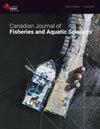加利福尼亚暗流对太平洋鳕鱼分布的空间变化影响
IF 2.2
2区 农林科学
Q2 FISHERIES
Canadian Journal of Fisheries and Aquatic Sciences
Pub Date : 2023-10-18
DOI:10.1139/cjfas-2023-0202
引用次数: 0
摘要
在加利福尼亚洋流生态系统中,加利福尼亚暗流(CU)是主要的地下洋流,它将富含营养的水从加利福尼亚南部向极地输送。在本研究中,我们使用了大量的空间明确的太平洋鳕和CU(36.5-48.3°N)的原位观测数据集来估计北向暗流速度与鳕分布之间的关系,并确定这种关系是否在空间或生活史阶段变化。我们发现,黑鸦的发生和密度都与CU有很强的空间复杂关系。在44°N以北地区(俄勒冈中部),CU效应在空间上是一致的,在产率(负)和密度(正)上是相反的,表明在该地区,hake可能聚集在高北向速度的地区。在44°N以南地区,CU效应在产率和密度上均呈现跨陆架梯度,表明该地区向北流速越高,近岸鳕分布越多。总之,我们的研究结果表明,气候变化导致的未来CU变化可能对北部和南部地区的hake产生不同的影响。本文章由计算机程序翻译,如有差异,请以英文原文为准。
Spatially-varying effects of the California Undercurrent on Pacific hake distribution
In the California Current Ecosystem, the California Undercurrent (CU) is the predominate subsurface current that transports nutrient rich water from southern California poleward. In this study, we used a large data set of spatially explicit in situ observations of Pacific hake and the CU (36.5–48.3°N) to estimate relationships between northward undercurrent velocity and hake distribution and determine if these relationships vary across space or life-history stage. We found that both hake occurrence and density had strong spatially complex relationships with the CU. In areas north of 44°N (central Oregon), the CU effect was spatially consistent and opposite for occurrence (negative) and density (positive), indicating that hake may aggregate in areas of high northward velocity in this region. In areas south of 44°N, the CU effect showed a cross-shelf gradient for both occurrence and density, indicating a more nearshore hake distribution when northward velocity is higher in this region. Together, our results suggest that future changes in the CU due to climate change are likely to impact hake differently in northern and southern areas.
求助全文
通过发布文献求助,成功后即可免费获取论文全文。
去求助
来源期刊

Canadian Journal of Fisheries and Aquatic Sciences
农林科学-海洋与淡水生物学
CiteScore
4.60
自引率
12.50%
发文量
148
审稿时长
6-16 weeks
期刊介绍:
The Canadian Journal of Fisheries and Aquatic Sciences is the primary publishing vehicle for the multidisciplinary field of aquatic sciences. It publishes perspectives (syntheses, critiques, and re-evaluations), discussions (comments and replies), articles, and rapid communications, relating to current research on -omics, cells, organisms, populations, ecosystems, or processes that affect aquatic systems. The journal seeks to amplify, modify, question, or redirect accumulated knowledge in the field of fisheries and aquatic science.
 求助内容:
求助内容: 应助结果提醒方式:
应助结果提醒方式:


